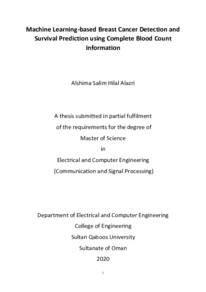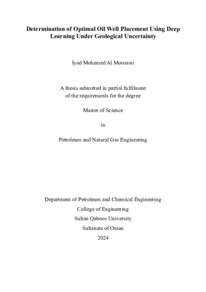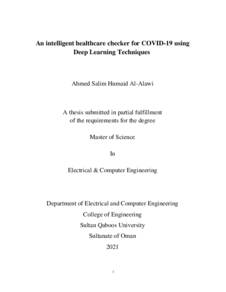وثيقة
Machine learning-based breast cancer detection and survival prediction using complete blood count information.
الناشر
Sultan Qaboos University.
ميلادي
2020
اللغة
الأنجليزية
الملخص الإنجليزي
This work is about breast cancer which is one of the main causes of mortality in women.
Early detection remains very crucial to improve survival among breast cancer patients. In this
project two main topics are investigated. The first one is related to the automatic detection of
breast cancer using complete blood count (CBC). The second one deals with the prediction of
survival among breast cancer patients. Both detection and prediction go through two stages,
namely feature selection and classification. Different techniques are used for feature
selection. These techniques belong to either the filter approach or the wrapper approach. In
the classification stage, number of machine learning algorithms are used to classify the data
in to two classes, namely cancer and cancer-free for detection version and survive and die for
survival prediction version. Last stage is to evaluate the evaluation metrics like: accuracy,
sensitivity, specificity and area under the curve (AUC). In the breast cancer detection CBC
results at first entry to the clinic give better evaluation metric with 78.8% accuracy and AUC
equal to 0.89. On the other hand, in survival prediction, CBC at the diagnosis date gives
better evaluation metrics with 90.5% accuracy and 0.93 for AUC. The algorithms are
evaluated using CBC data collected and labelled by experts from Sultan Qaboos University
Hospital.
المجموعة
URL المصدر
الملخص العربي
هذا العمل يتحدث عن سرطان الثدي والذي يسبب العدد الأكبر من الوفيات. التشخيص المبكر لهذا المرض هو عامل أساسي لتحسين فرصة النجاة للمريض. في هذا المشروع لدينا جزأين أساسيين: الجزء الأول عن تشخيص سرطان الثدي باستخدام خصائص مستخرجة من فحص الدم الشامل. الجزء الثاني يناقش التنبؤ بحياة مريض سرطان الثدي. يضم كل جزء من الجزأين الأساسيين المراحل التالية: المرحلة الأولى هي استخراج الخصائص المهمة من خصائص فحص الدم الشامل وذلك باستخدام خوارزميات معينة لاستخراج وترتيب هذه الخصائص حسب أهميتها. المرحلة الثانية تكون بتصنيف البيانات باستخدام تقنيات معينة للتصنيف. تصنف البيانات في حالة التشخيص إلى سليم أو مريض بالسرطان، أما في حالة التنبؤ بحياة مريض السرطان فسوف تصنف البيانات إلى شخص ناجي من المرض أو شخص غير ناجي منه. وهذه البيانات تضم المصابين بالسرطان فقط. إن المرحلة الأخيرة هي حساب معايير التقييم لتحديد أفضل تقنية تصنيف وتضم هذه المعايير: الدقة، الحساسية، النوعية، والمساحة تحت المنحنى وبعض المعايير الأخرى. تتضمن نتائج تشخيص سرطان الثدي أن فحص الدم الشامل الأول عند دخول المريض للمستشفى تعطي أفضل النتائج بدقة 7.87 %ومساحة تحت المنحنى 70.9 . وفي حالة التنبؤ بحياة مريض سرطان الثدي فإن أفضل النتائج تكون في حالة فحص الدم الشامل عند تاريخ التشخيص بدقة تساوي 9.09 %ومساحة تحت المنحنى تساوي 00.9.
قالب العنصر
الرسائل والأطروحات الجامعية



